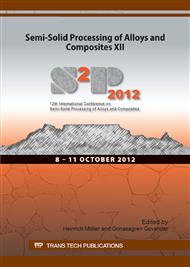p.392
p.398
p.404
p.410
p.415
p.422
p.428
p.433
p.441
Effect of the Parameters in Inverted Cone-Shaped Pouring Channel Process on the Microstructure of Semi-Solid 7075 Aluminum Alloy Slurry
Abstract:
The semi-solid slurry of 7075 aluminum alloy was prepared by using an innovative non-stirring technology that can be called inverted cone-shaped pouring channel process (ICSPC). The effect of pouring temperature and structural parameters of the channel on the microstructure of semi-solid 7075 aluminum alloy slurry was investigated. The experimental results reveal that when keeping the pouring temperature within some range, the slurry with spherical primary α(Al) grains can be prepared by ICSPC process, and with the decline of the pouring temperature, the microstructure of semi-solid 7075 aluminum alloy is more desirable under the same channel. The appropriate combination of channel length and interior surface slope can also give rise to a transition of the growth morphology of primary α(Al) from coarse dendritic to coarse particle-like and further to fine-globular at the same pouring temperature. In ICSPC process, numerous effective heterogeneous nucleation takes place in the melt as it flowed along the interior surface of the channel and the morphology of primary α(Al) grains is virtually determined by the degree of contact condition between the superheat melt and the interior surface of the channel. A better contact condition stands for a stronger heat extraction from the melt, and will finally appear as a remarkable increase of primary α(Al) grains survived in the melt, which will conspicuously promote the spherical growth of the primary α(Al) grains.
Info:
Periodical:
Pages:
415-421
Citation:
Online since:
October 2012
Authors:
Price:
Сopyright:
© 2013 Trans Tech Publications Ltd. All Rights Reserved
Share:
Citation:


